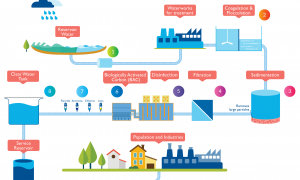🕑 Reading time: 1 minute
Hydrology and hydrological cycle are important science that deals with the depletion and the replenishment of the water resources. The knowledge of hydrology is necessary to perform design, operation and maintenance of the water resource engineering projects.
Contents:
What is Hydrology?
Hydrology is the study of occurrence and movement of water above or below the surface of the earth. The study embraces the entire domain of water present in earth, its history along with its quantitative use on the earth.
A civil engineer must have the basic knowledge of hydrology to engage in the design, planning and the construction of several irrigation structures, flood control works, bridges and highway culverts.
What is the Hydrological Cycle?
Hydrological cycle can be defined as the continuous process of exchange of water from the earth surface to the atmosphere or vice versa by the influence of solar radiation or solar heat.
It is a closed system where the water gets transformed either from one place to other or from one form to other under the action of sun heat. Whatever be the process, the total water in the whole system remains constant. The representation of the hydrological cycle is represented in the figure-1 below.

The hydrological cycle is involved in the total earth system. The total system can be classified into three important zone: Atmosphere, hydrosphere and lithosphere. Atmosphere forms the gaseous envelope that is above the hydrosphere. Hydrosphere forms the body of water that is covering the surface of the earth. The environment that is below the hydrosphere till the solid rock forms the lithosphere.
What are the basic components of Hydrological Cycle?
The basic components of a hydrological cycle constitute:
- Precipitation
- Runoff
- Evaporation
- Condensation
- Transpiration
- Evapotranspiration
- Infiltration
- Depression Storage
- Interception
1. Precipitation
It is the fall of moisture from the atmosphere to the earth’s surface in any form. Example: rain, hail, snow, sleet, glaze, drizzle, snowflakes.
2. Runoff
It is the water flowing over the land making its way towards rivers, lakes, oceans, etc. as surface or subsurface flow.
- Surface runoff: it is the running water over the land and which ultimately discharge water to the sea.
- Subsurface runoff: The water getting infiltrated into pervious soil mass, making its way towards rivers and lakes can be termed as subsurface runoff.
3. Evaporation
It is the conversion of natural liquids like water into gaseous form like air. Evaporation happens in the water bodies
4. Condensation
It is the conversion of a vapor or gas to a liquid. The water vapour evaporates from the water bodies like ocean, sea and river. These vapors after reaching a height around 20km in the sky undergo condensation and forms clouds. These later precipitate as rain, fog etc.
5. Transpiration
It is the evaporation taking place from any plant or greenery. For example, a water droplet on a leaf getting evaporated into the atmosphere.
6. Evapotranspiration
It is the combination of evaporation and transpiration.
7. Infiltration
It is the process of filtration of water to the inner layers of soil based on its structure and nature. Pervious soils go through more infiltration than impervious. Infiltration in soils like sand, gravel and coarser material is more and for finer soil particles like clay and silt, infiltration is less.
Infiltration is inversely proportional to runoff. In soil, if infiltration is less, then the runoff is more. Similarly, more infiltration gives less runoff. Example: bitumen roads have more runoff than metallic red mud roads
8. Depression Storage
It is the part of precipitation required to fill depression zones of land.
9. Interception
Part of precipitation required to wet the surface of soil, buildings and all pervious surfaces is called Interception.
Process of Hydrological Cycle
The Process of the hydrological cycle starts with oceans. Water in oceans, gets evaporated due to heat energy provided by solar radiation and forms water vapor. This water vapor moves upwards to higher altitudes forming clouds.
Most of the clouds condense and precipitate in any form like rain, hail, snow, sleet. And a part of clouds is driven to land by winds. Even during the process of precipitation, some parts of water molecules may evaporate back to atmosphere.
The Portion of water that reaches the ground, enters the earth’s surface infiltrating various strata of soil. This process enhances the moisture content as well as the water table.
Vegetation sends a portion of water from the earth’s surface back to the atmosphere through the process of transpiration. Once water percolates and infiltrates the earth’s surface, runoff is formed over the land, flowing through the contours of land heading towards river and lakes and finally joins into oceans after many years. Some amount of water is retained as depression storage.
Further again the process of this hydrological cycle continues by blowing of cool air over the ocean, carrying water molecules, forming into water vapor then clouds getting condensed and precipitates as rainfall. Similarly, the water percolates into the soil, thus increasing the water table and also the formation of runoff waters heading towards water bodies. Thus the cyclic process continues.
Water balance Equation
As per the water balance equation, the sum of inflow waters = sum of outflow waters. Out of the three processes precipitation, runoff, and evaporation, inflow is precipitation. Runoff and evaporation comes under outflow, then the water balance equation can be written as,
Precipitation – runoff = Evaporation
That gives,
Precipitation (P) = Evaporation (E) + Runoff (R)


